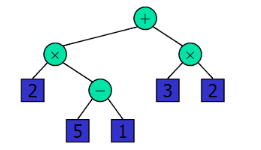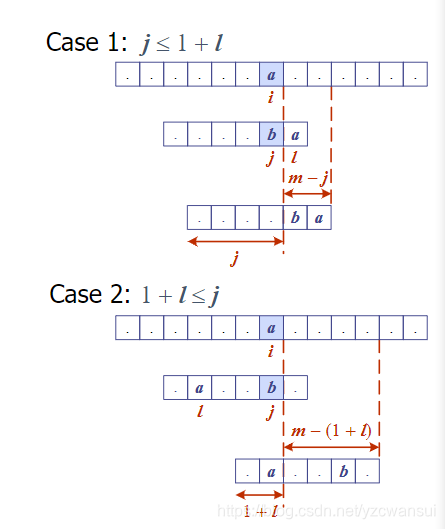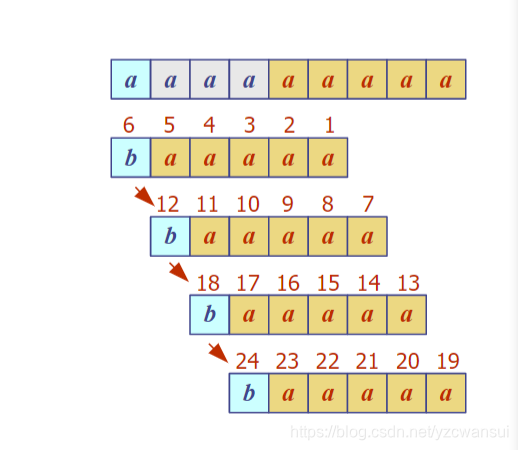Binary Search
BinarySearch(v, a, lo, hi)
input value v
array a[lo...hi] of values
output true if v in a[lo...hi]
false otherwise
mid = (lo + hi)/2
if lo > hi return false
if a[mid] = v return true
else if a[mid] < v
return BinarySearch(v, a, mid + 1, hi)
else
return BinarySearch(v, a, lo, mid - 1)
Computing ploynomial
The ploynomial can be recursively computed as
p0=an
p_{0} = a_{n}
p0=an
pi+1=pix+ai
p_{i+1} = p_{i}x+a_{i}
pi+1=pix+ai
Algorithm computingPloynomial(x, n , A[])
p = A[n]
for(i = 1; i < n+1; i++){
p = p*x + A[n -1]
}
return p;
Tree
Computing Depths
O(n)
Algorithm computingDepths(v, d)
{
v.depth = d;
if v has no child
return;
else
for each child v' of v do
computingDepths(v', d+1);
return;
}
Preorder Traversal
Algorithm preOrder(v){
visit(v);
for each child w of v
preorder(w);
}
Algorithm preOrder(v)
if v = null;
return;
Create an empty stack S;
S.push(v);
while S is not empty
v = S.pop()
visit(v)
if hsaRight(v)
S.push(right(v))
if hasLeft(v)
S.push(left(v));
Postordert Traversal
Algorithm postOrder(v):
{
for each child w of v
postOrder(w);
visit(v);
}
Algorithm postOrd3erTraversal(v)
Create an empty stack S;
lastNodeVisited = null;
while S is not empty or v != null
if v != null //push v and each left descendant onto the stack
s.push(v)
v = left(v)
else
topNode = S.top();
//if topNode has a right child not visited before then move to the right child of topNode
if topNode.right != null and lastNodeVisited != topNode.right
v = topNode.right
else //both left and right subtree of topNode has been traversed
visit(topNode);
lastNodeVisited = S.pop();
Inordert Traversal
only for Binary tree
Algorithm inOrder(v)
{
if v has a left child
inOrder(v.left)
visit(v)
if v has a right child
inOrder(v.right)
}
An inorder traversal of a binary search trees visits the keys in non-decreasing order
Algorithm inOrderTraversal(v)
Create an empty stack S;
while S is not empty or v != null
if v != NULL //keep going left until v = null
S.push(v);
v = left(v);
else
v = S.pop() //v has no left child, so visit it
visit(v);
v = right(v) //go to the tight child
Inorder predecessor(v)
Algorithm inOrderPredecessor(v)
if v= null
return null
if left(v) != null //V has a left child
v = left(v)
while right(v) != null
v = right(v);
return v;
else
if v is root
return null;
while parent(v) != null
if right(parent(v)) = v //v is the right child of its parent
return parent(v);
else
v = parent(v)
return null; //no inorder predecessor
Evaluate Arithmetic Expressions

Specialization of a postororder traversal
Algorithm evalExpr(v)
{
if v is a left node
return v.element
else
x = evalExpr(v.left);
y = evalExpr(v.right);
operator = operator stored at v,
return x <operator> y;
}
BST
Search
Time complexity O(n) , 最坏情况:链表(极度不平衡)
TreeSearch(v, k)
Input v(node), k(key)
output the node
if v is null or v.key = k
return v;
if k<v.key
return TreeSeach(v.left, k);
else
return TreeSearch(v.right, k);
Insert
be careful: insert equal keys in the left subtree
Time complexity: O(n), 最坏情况:链表(极度不平衡)
TreeInsert(v, k)
input v(node), k(key)
output none
if root = null //empty tree
root = CreateNode(k) //create a root to store k
else if k < v.key //insert the duplicate keys in the left subtree
if v.left = null
v.left = CreateNode(k); //insert a new node as left child of v
else
TreeInsert(v.left, k);
else if k > v.key
if k > v.key
if v.right = null
v.left = CreateNode(k);
else
TreeInsert(v..right, k);
Deletion
Find all entries with key k
Algorithm findAll(k)
Input The search key k, the root v of the binary search tree T
Output: A list L containing all the entries with the key k
while(v != NULL)
if v.key = k
findAllEntries(v, L)
return L;l
else
if v.key > k
v = v.left
else
v = v.right
return L;
Algorithm findAllEntries(v, L)
Input: A node v with the key k and a List L
Output: All the entries with the key k in the subtree rooted at v
//recursive pre-order traversal to find all entries
if v.key = k
Add v to L;
if v.left != NULL
FindAllEntries(v.left, L)
if v.right != NULL
FindAllEntries(v.right, L)
return;
Time complexity:
- Finding the first node with the key k takes O(h) time.
- Since at 2s nodes are visited by findAllEntries(), traversing the subtree rooted at the first node takes O(s) times
Total is O(h + s)
AVL TREE
AVL tree is a binary search tree
AVL trees are balanced
height of an AVL tree storing n keys is O(log(n))
- a single restructure is O(1)
- find is O(log(n))
- Insert is O(log(n))
- delete is O(log(n))
Splay Tree
- is binary tree
- node is splayed after it is accessed
- splay cost O(h)
- O(h) worst-case is still O(n)
(2, 4)Tree
A (2, 4) tree storing n items has height O(log(n))
Overflow and Split
Insert
Algorithm insert(k, o)
search for key k to locate the insertion node vi //lO(og(n))
add the new entry (k, o) at node vi //lO(1)
while (overflow(v)){ //lO(og(n))
if (isRoot(v))
create a new empty root above vi
v = split(v);
}
Deletion
- visit O(log(n)) nodes
- each fusion and transfer takes O(1) time
- handle an underflow with a series of O(log(n))
deleting an item from a (2, 4)tree takes O(log(n)) time
underflow and Fusion
the adjacent sibling of v are 2-nodes
Fusion operation: merge adjacent sibing and move an entry from parent to the merged node
after a fusion, the under flow may propagate to the parent node

underflow and Transfer
an adjacent sibling is a 3-node or a 4-node
Transfer operation
1. move an item from u to v
2. move an item from w to u
after a transfer, no underfolw occurs
Priority Queue Sorting
Algorithm PQ-Sort(S)
Input sequence S
Output sequence S sorted in non-decreasing order
{
Create an empty priority queue P
while(! IsEmpty(S)){
e = RemoveFirst(S);
Insert(P, e);
}
while (! IsEmpty(P)){
e = RemoveMin(P);
InsertLast(S, e);
}
}
updating the key of an item in a priority queue
Assume the priority queue is based on a min-heap
Algorithm updateKey(v)
Input: a node v containing the item
Output: the heap with the key updated
//upheap bubbling
while(v != NULL && v.key < parent. key)
swap the item of v and its parent
v = v.parent
//dowmheap bubbling
while(v != NULL && v.key > min (v.left.key , v.right.key))
let u be the child of v with the smaller key;
swap the item of v and u;
v = u;
Time complexity analysis:
- each while loop take O(1)
- each loop is no more than h
- h is O(log(n))
total time complexity is O(log(n))
compute all the items in heap with key less or equal to k
Algorithm lessThanOrEqualToKEntries(H, v)
input:A heap H and a node v
output: A node list L than contains all the entries with keys less than k
if v.key <= k
L.add((v.key, v.value)); //add the entry v to the list L
if v.leftchild != null
LessThanOrEqualToKentires(H, v.leftchild);
if v.rightchild != null
LessThanOrEqualToKEntries(H, v.rightchild)
this algorithm takes O(n) times where n is the number of entries returned.
Flyers upgrade coupon(base on miles accumulated)
Algorithm TopKFlyers(A)
Input: A list A of n flyers
Output: An array B of the top log n flyers
Construct a heap H storing all the n flyers, where the key of each flyer Pi is 1/mi
for(i = 0; i < log n; i++)
B[i] = H.removeMin();
return B
Heap merge(Binary trees)
Algorithm treeUnion(T1, T2)
Input: Two trees T1 and T2 that satisfy the heap-order property
Output: A tree T that is the union of T1 and T2 and also satisfies the heap-order property
v = T1.removeMIN(); //O(h1)
let v be the root of T;
leftchild(v) = the root of T1
rightchild(v) = the root of T2
apply the down heap bulling to the tree T; //O(h2)
The complexity is O(h1 + h2)
String
Brute-Force Pattern Matching
time complexity is O(nm)
Algorithm BruteForceMatch(T, P)
Input text T of size n and pattern
P of size m
Output starting index of a substring of T equal to P
or -1 if no such substring exists
for(i = 0; i < n-m+1; i++){
j = 0;
while(j<m && T[i+j] = p[j])
j = j+1
if(j = m)
return i; //match at i
return -1; //no match anywhere
}
Boyer-Moore Heuristics
Last-Occurrence Function
define as
- the largest index i such that P[i] = c or
- -1 if no such index exists
The last-occurence function can be computed in time O(m+s), where m is the size of P and s is the size of alphabeta
//Boyer-Moore Algorithm
Algorithm BoyerMooreMatch(T, P, D){
L = lastOccurenceFunction(P, D) //O(m+n)
i = m-1;
j = m -1
repeat
if T[i] = P[i] //run m-1 times in worst case, before character-jump
if j = 0
return i; //match at i
else
i = i - 1;
j = j -1;
else //character-jump, run 1 times every m times in worst case
l = L[T[i]];
i = i + m - min(j, 1 + l);
j = m - 1;
until i > n - 1 //run n times in worst case
return -1 //no match
}

Boyer-Moore’s algorithm runs in time O(nm + s)
The worst case

KMP Algorithm
Preprocessing Pattern
KMP failure Function
preprocesses the pattern to find matches of prefixes of the pattern.
The failure function can be represented by an array and can be computed in O(m) time
Algorithm failure Function(P)
F[0] = 0;
i = 1;
j = 0;
while i < m
if P[i] = P[j] //matched j + 1 char
F[i] = j + 1;
i = i + 1;
j = j + 1;
else if j >0 //use failure function to shift P
j = F[j - 1];
else //no match
F[i] = 0;
i = i + 1;
The KMP algorithm
The KMP’s algorithm runs in optimal time O(m+n)
Algorithm KMPMatch(T, P)
F = failureFuncion(P);
i = 0;
j = 0;
while i < n
if T[i] = P[j] //char match
if j = m - 1 //match
return i - j;
else
i = i + 1;
j = j + 1;
else //failure to match
if j > 0
j = F[j - 1]
else
i = i + 1
return -1; //no match
Preprocessing Text
If the text is large, immutable and searched for often, proprocessing the text instead of the pattern
Standard Tries
- O(n) space and support searches
- O(dm) insertion
- O(dm) deletion
n is total size of the string in S
m size of the string parameter of the operation
d size of the alphabet
Compressed Tries
Graph
A graph is a pair (V, E) where
- V is a set of nodes, called vertices
- E is a collection of pairs of vertices, called edges
- Vertices and edges are positions and store elements
Edge type:
- Directed edge(ordered pair of vertices)
- Undiected edge(unordered pair of vertices)
Properties
- ∑v=2m\sum\nolimits_{v} = 2m∑v=2m
- In an undirected graph with no self-loops and no multiple edges m≤n(n−1)/2m \leq n(n - 1)/2m≤n(n−1)/2
Graph Representations
Adjacency matrix
Advantages
- easily implemented as 2-dimensional asrray
- can represent graph, digraphs and weighted graphs
Disadvantages
- if few edges(sparse) => memory-inefficient
Space complexity is O(n2)O(n^{2})O(n2)
Graph Initialization
O(n2)O(n^{2})O(n2)
newGraph(n)
input number of nodes n
Output new empty graph
g.nV = n;
g.nE =0;
allocate memory to g.edges[][]
for all i, j = 0 ... n-1 do
g.edges[i][j] = 0;
return g;
Edge Insertion
O(1)O(1)O(1)
insertEdge(g, (v, w))
input : graph g, edge(v, w)
if (g.edges[v][w] = 0)
g.edges[v][w] = 1;
g.edges[v][w] = 1;
g.nE = g.nE + 1;
Edge Removal
O(1)O(1)O(1)
RemoveEdge(g, (v, w))
Input graph g, edge(v, w)
if g.edges[v][w] = 0
g.edge[v][w] = 0;
g.edge[w][v] = 0;
g.nE = g.nE - 1;
Adjacency lists
Advantages
- relatively easy to implement
- memory efficient if E:V relatively small
Disadvantages:
- one graph has many possible representations unless lists are ordered by same criterion.
space complexity is O(n+m)O(n + m)O(n+m)
Graph Initialization
O(n)O(n)O(n)
newGraph(n)
Input number of nodes n
Output new empty graph
g.nV = n;
g.nE = 0;
allocate memory for g.edges[]
for all i = 0...n-1 do
g.edges[i] = NULL
return g
Edge Insertion
O(1)O(1)O(1) if don’t check for duplicates
insertEdge(g, (v, w))
Input: graph g, edge (v, w)
if inLL(g.edges[v], w)
insertLL(g.edges[v], w)
insertLL(g.edges[w], v)
g.nE = g.nE + 1;
Edge Removal
O(m)O(m)O(m)
removeEdge(g, (v, w))
Input graph g, edge (v, w)
if inLL(g.edges[v], w)
delete(g.edges[v], w);
delete(g.edges[w], v);
g.nE = g.nE - 1;
DSGs and Topogical Ordering
A digraph admits a topological ordering if and only if it is a DAG
Algorithm TopologicalSort(G)
G1 = G.copy()
seq_num = n // assume n is the number of vertices
while (G1 is not empty)
for each vertex v without outgoing edges
v.seq = seq_num
seq--
removeFrom(G, v)
BFS
vertex
- unexplored verrtex
- visited vertex
edge
- unexplored edge
- discovery edge
- cross edge
Property
- BFS visits all the vertices and edges
- discovery edges labeled form a spanning tree
Algorithm BFS(G)
for v in G.vertexes:
v.label= UNEXPLORED
for e in G.edges
e.label = UNEXPLORED
for v in G vertexes:
if v.label = UNEXPLORED
BFS(G, v)
Algorithm BFS(G, v)
Queue Q
v.label = VISITED
Q.add(v)
while(Q is not empty)
v = Q.dequeue()
for e in incidentEdges(v)
if e = UNEXPLORED
w = opposite(v, e)
if w = UNEXPLORED
w.label = VISITED
e.label = DISCOVERY
Q.enqueue(w)
else
e.label = CROSS
Shortest path(unweighted graph)
O(m+n)
Algorithm BFS(G, v)
Queue Q
for i in G.v
create an empty list L[i] for i
v.label = VISITED
Q.enqueue(v)
while( Q is not empty)
v = Q.dequeue()
for e in incidentEdge(v)
if e = UNEXPLORED
w = opposite(v, e)
if w = UNEXPLORED
w.label = VISITED
e.label = DISCOVERY
Q.enqueue(w)
L[w] = L[v] + {v, w}
else
e.label = CROSS
DFS
vertex
-
unexplored vertex
-
visited vertex
edge -
unexplored edge
-
discovery edge
-
back edge
Property
- DFS visits all the vertices and edges in the connected component of v
- The discoivery edges labeled by DFS(G, v) form a spanning tree of the connected component of v
DFS (recursive version)
O(m+n)
incidentEdges Function is called
Algorithm DFS(G)
for v in G.v
v.label = UNEXPLORED
for e in G.v
e.label = UNEXPLORED
for v in G.v
if v = UNEXPLORED
DFS(G, V)
Algorithm DFS(G, v)
v.label = VISITED
for e in v.edges
if e.label = UNEXPLORED
w = opposite(v, e)
if w.label = UNEXPLORED
w.label = VISITED
e.label = DISCOVERY
DFS(G, v)
else
e.label = BACK
Path Finding
Algorithm pathDFS(G, v, z)
Stack S
v.label = VISITED
if v = z
return S.element()
for e in incidentEdges(v)
if e.label = UNEXPLORED
w = opposite(v, e)
if w = UNEXPLORED
S.push(e)
e.label = DISCOVERY
pathDFS(G, w, z)
S.pop()
else
e.label = BACK
Cycle Finding
Dijkstra
Dijkstra(G, s)
for each v in G
if v = s
D[v] = 0;
else
D[v] = inf
Create priority queue Q, which cantain all the vertex of G using D labels as key
While Q is not empty
u = Q.removeMin()
for w in AdjacentNodes(u)
if D[w] > D[u] + {u, w} //relax
D[w] = D[u] + {u, w}
w.from = u
Q.update(w)
return the label D[u]
Bellford
O(mn)
Algorithm Bellford(G, s)
for each vertex v in G
if v = s
D[v] = 0
else
D[v] = inf
for (i = 1; i < n - 1; i++)
u = G.origin(e)
z = G.opposite(u, e)
r = D[u] + weight
if D[z] > r
z.from = u
D[z] = r
Kruskal’s
for each vertexs create a cloud of {v}
create a priority queue Q and insert all edges using their weight as the key
T = empty
while Q is not empty
e = Q.removeMin()
u, v = the endpoint of e
if cloud(u) != cloud(v)
add e to T
merge cloud(u) and cloud(v)
return T
Prim
Algorithm PrimJarnikMST(G)
Pick any vertices v of G
D[v]= 0
for each u in G.vertices with u != v
D[u] = inf
Create a priority queue Q with an entry ((u, null), D[u])
D[u] is the k
while Q is not empty
(u, e) = Q.removeMin();
T.add(e)
for v in AdjacentNode(u)
D[v] = weight(u, z)
update all element (z, (u, z))
Change D[z]
return T
LCS
Algorithm LCS(x, y)
Array L[x.len + 1][y.len + 1] = {0}
for i in range( x.len)
for j in range( y.len)
if x[i] = y[j]
L[i][j] = L[i - 1][j - 1] + 1
else
L[i][j] = max(L[i - 1][j], L[i][j - 1])
return L





















 4246
4246

 被折叠的 条评论
为什么被折叠?
被折叠的 条评论
为什么被折叠?








